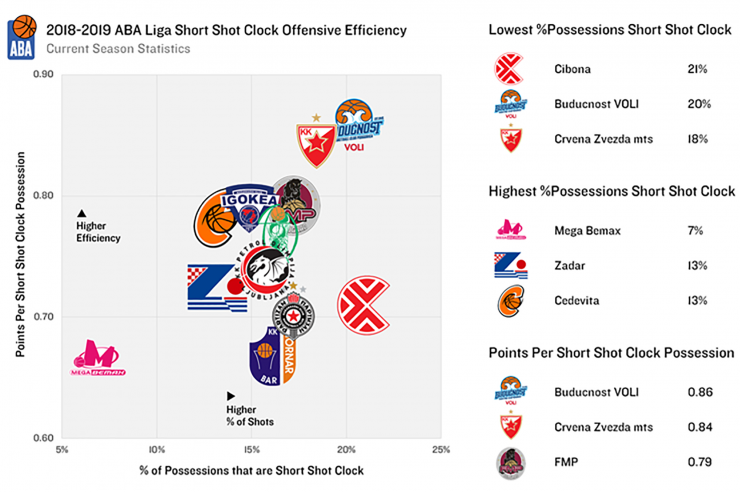Analysis: Short shot clock offensive efficiency
Round 15 of the ABA League is over, and the grind of the season has taken its toll on the pace of games.

(Photo: Synergy Sports Technology)
Over the course of an ABA League season, the pace of games typically slows down. This makes a team’s ability to perform deep into offensive possessions more important as they attempt fewer early shots and push the ball less frequently towards the end of the year. 15.9% of all possessions in the ABA League are used with less than four seconds on the shot clock and almost every player in the competition gets between 10% and 25% of their possessions in that range. Possessions under those conditions are less efficient that other half court possessions resulting in only 0.75 points per possession, well below the 0.92 points per possession teams are averaging overall in the half court.
Digging Deeper
The graph above displays the ABA League’s most efficient short shot clock scoring teams in terms of points per possession compared to the percentage of the team’s possessions that come in short shot clock situations. It offers some interesting insight into how pace differs even in the half court as well as which teams hold an edge as the season grinds on.
A team’s aggressiveness pushing the ball in transition has a major effect on their pace of play, but so too does the way they look for shots in their half court offense. Some teams are much more aggressive than others looking for early openings off quick hitting plays. Mega Bemax is the best example of that this season, as they do not frequently work deep into the shot clock and lead the ABA League in possessions per game by a wide margin.
In contrast, Cibona, Budućnost VOLI, and Crvena zvezda mts all operate deep into the shot clock on almost a quarter of their half court possessions. Budućnost and Zvezda also rank as the two most efficient short shot clock scoring teams in the ABA League this season due in large part to their shot making and ability to draw fouls with only seconds on the clock. While some teams begin to rush with the clock winding down, both of those clubs continue to execute fairly well, even if their efficiency falls well below the nearly 1.00 points per possession they score in the half court overall.
Late clock execution means different things to different teams. In Budućnost’s case, they do a very good job getting the ball to their playmakers—namely Earl Clark and Nemanja Gordić—when the clock dwindles. In comparison, no player on Zvezda uses a high volume of the team’s short shot clock possessions, but the team’s guards do a nice job creating for others with limited time remaining. Regardless, a team’s ability to make plays under pressure from the clock becomes more and more important as the season wears on.
Insights and Statistics Provided by Synergy Sports Technology

